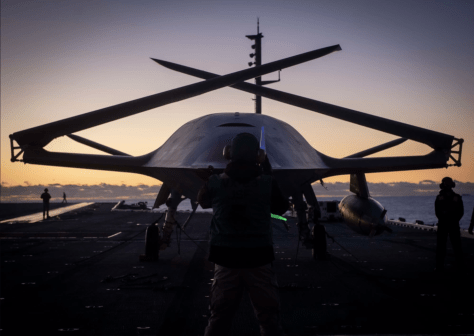Anduril, Palantir awarded contracts for Army robotic combat vehicle software system integration

The Pentagon’s Defense Innovation Unit awarded deals to Anduril Industries and Palantir Technologies to develop software system integration architectures that could aid the Army’s Robotic Combat Vehicle program, the organization announced Wednesday.
The move comes as the Army is looking to acquire new unmanned platforms for intelligence, surveillance, reconnaissance and strike missions to help it achieve what it calls “human-machine integrated formations.” DIU, meanwhile, is trying to help the U.S. military acquire capabilities from nontraditional contractors.
The RCV program has several key components, including platforms, payloads and software.
McQ, Textron Systems, General Dynamics Land Systems and Oshkosh Defense have been tapped by the Army for phase one of a vehicle prototyping effort.
DIU also awarded deals to four autonomous navigation vendors — Forterra, Kodiak Robotics, Neya Systems and Overland AI — and two machine learning and autonomy pipeline vendors, Applied Intuition and Scale AI. Now, Anduril and Palantir have been selected to participate in the initiative as software system integrators, the unit said in a release.
“We are excited to work with these best-in-class autonomy providers, software experts, and systems integrators as we drive towards merging software capabilities developed through the RCV Software Acquisition Pathway (SWP) into the RCV Full System Prototype (FSP),” Steve Herrick, Army RCV product manager, said in a statement Wednesday. “Our software system integrators will also be the first to implement Traceability, Observability, Replaceability, and automated Consumption (TORC) compliance for Army software-centric ground vehicles, thereby helping the Army ensure programmatic flexibility and performance over time.”
According to Anduril, the company will produce a prototype architecture and framework that will enable RCV variants to autonomously navigate varied terrain, seamlessly transition between multiple third-party and government-owned autonomous mobility stacks, and allow for autonomous or remote management of vehicle payloads, sensors and “effectors.”
“Through the prototyping effort, Anduril will develop a DevSecOps and software integration platform, as well as associated APIs and network protocols, to provide a basis for rapidly developing, integrating, testing, and deploying external software modules, sensors, and payloads being evaluated for the RCV program for a variety of missions,” the contractor said in a release.
The dollar value of the software system integration contracts was not disclosed.
For fiscal 2025, the Army is requesting $93 million for research, development, testing and evaluation for the RCV initiative. It plans to spend about $140 million per year on RDT&E for the initiative through the remainder of the five-year planning period known as the future years defense program, according to budget documents.
The service hopes to begin fielding the platforms in fiscal 2028.
The Army envisions a variety of use cases for the uncrewed vehicles. Right now, it’s contemplating creating robotic autonomous system (RAS) platoons — consisting of unmanned aerial systems, RCVs and control vehicles — that could be integrated into its armored brigade combat teams.
“Out deep, what we’re looking to do, of course, is … increasing our situational awareness, making first contact using aerial and ground robots with the enemy. So developing our understanding of the battlefield, and then certainly leveraging fires, leveraging other effects to disrupt the enemy and throw them off their game from the outset,” Brig. Gen. Geoff Norman, commander of the next-generation combat vehicles cross-functional team at Army Futures Command, said last week at the AUSA Global Force conference.
“Not all of the payloads that might be on robotic combat vehicles are kinetic, lethal payloads. And in fact, we’re finding that some of the electronic warfare, electromagnetic warfare payloads are some of the most effective on the battlefield. [They provide] the ability to detect the enemy, the ability to deceive the enemy by emitting signatures that reflect a different size and type of organization,” he noted.
Closer to the frontlines, robotic combat vehicles could inhibit enemy forces’ ability to maneuver and help defeat them with direct and indict fires, Norman said.
Having modular payloads that can be easily integrated and swapped out will be critical, officials say.
“Those are really going to make the difference in this capability. At the end of the day, we’re delivering a robotic truck that could do many things … But what things you want it to do at any point in the battlefield in your particular operation, those may change from mission to mission and operation to operation. And having the ability to modularly change those payloads should give the commander tremendous flexibility. And we’ve seen that demonstrated already in the experimentation” that’s been conducted. Maj. Gen. Glenn Dean, program executive officer for ground combat systems, said at the conference.
However, the program faces challenges related to autonomy, software and communications.
“Certainly, autonomy is advancing at a rapid clip, so if you’re in the autonomy business and you’re moving the ball forward, thank you for what you’re doing. Keep up the great work and stay at it. Because autonomy is absolutely essential to realizing the promise of robotic and autonomous systems. But frankly, autonomy isn’t where we need it right now for those robotic systems to operate without human intervention or human control. Which brings us to the second challenge, and that is communications links. And so given that autonomy is where it is, we’re going to need to have teleoperation or control by humans for certain functions in the robots. So we need to have a communications link that … has sufficient strength and reliability and sufficient bandwidth for the data that’s going between the robot and the control vehicle, and vice versa,” Norman said.
Software and comms are shaping up to be the “Achilles’ heel” of the RCV initiative as the Army looks toward the future, Dean said.
“The issue is partly the amount of data we can transmit at a latency. And the other problem is the amount of spectrum we have to do that. Because what we’ve learned from our soldiers operating our surrogate prototypes is they want very high fidelity and very low latency. We cannot drive a robotic combat vehicle more than about 25 miles an hour under teleoperation safely. There is too much latency in most communications. Okay, well, how do you handle that? Well, you end up with a really big data pipe. And if you have a really big data pipe, you end up needing a lot of spectrum to pass that data through,” he said.
“There is not enough spectrum allocated to military operations, the way we do it today, for us to operate any sort of reasonable density of robotic ground combat vehicles on the battlefield the way we currently do through teleoperation. So, if there is an area that is critical and essential to growth, is how you handle your control and how you handle data latency and how you manage spectrum. And we’re gonna have to give commanders the ability to dynamically manage spectrum, because they may have to trade capability and spectrum capability between air platforms and ground platforms if they have a relatively robotic dense formation,” he added.
However, the RCV program’s software pathway could yield solutions to the problem.
“That’s our method to grow out of teleoperated control. So we now have six contractors under contract either doing software integration or developing individual autonomy capabilities. And so whether it’s aided target detection, or waypoint navigation, or it’s something else we can automate on the platform — that then does not require regular intervention by the robot operator and that’s how we solve our way out of the spectrum and bandwidth problem,” Dean said.
“And that’s ultimately how we get from our current density of two soldiers operating one robot, to one soldier operating one robot, to one soldier operating two, then four, then eight, is we have to have the autonomous capabilities. You see it already in unmanned aircraft. Right. You can see swarms operated by a very small number. Yeah, the swarms don’t have to maneuver on the ground, which, frankly, is a very hard problem. And even our commercial autonomy industry really doesn’t have the military-relevant datasets to enable the development of autonomous algorithms that will matter for us when we need to maneuver offroad. So that’s the other significant challenge in our autonomous space,” he added.






